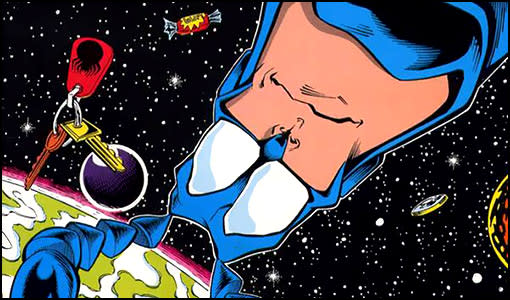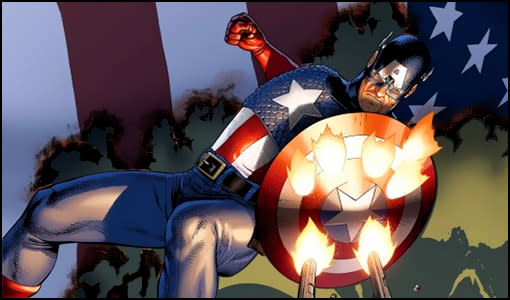Superhero Showdown, Round 3: Batman vs. Wolverine! Captain America vs. Iron Man!
And so it has come to this: The final two matchups in the quarter-final round of our Superhero Showdown bracket game. In the first face-off, two of the most popular heroes in the whole history of fiction will fight for domination: It’s Batman vs. Wolverine, two superheroes who arguably define their respective comic book universe, two characters who have headlined some of the most important stories in comic book history (not to mention a few movies you might have heard about.) Then, witness a showdown between two old friends and teammates: Iron Man vs. Captain America. There can only be one!
Click on the image above for a printable bracket. Check out our pocket biographies of each superhero, and scroll to the bottom of each page to register your vote. Voting will conclude in on Monday, at 2:00 PM EST. And there’s still time to vote in yesterday’s quarter-final battles: Superman vs. Hellboy, and Spider-Man vs. Green Lantern.
Northeast Regional Final: Batman vs. Wolverine

Name: Batman
Origin Story: After watching a thug named Joe Chill kill his parents in cold blood in Crime Alley, Bruce Wayne devoted his life and considerable fortune to the cause of justice – and vengeance – in perilously bleak Gotham City by becoming the caped crusader known as Batman. To some, the dark knight is a criminal vigilante, just as gonzo wrong as the baddies he fights (and inspires). To others, the hero is an aspirational icon, bringing hope to a hopelessly corrupt world.
Costume: The model for all masked avengers. Sporting a black hooded cape and gray body armor with the ominous insignia square on his chest, Batman dresses for effect – that effect being terror. Inspired by the fearsome flying rodents that live in the cave underneath Wayne Manor, Bruce plays the part of mythical bogeyman to Gotham’s underworld – part Dracula, part Jungian shadow.
Coolest power: What makes Batman so cool is that he has no powers, save his smarts, brawn, and the array of gadgets and tools (but no gun) on his utility belt.
Defining stories: Detective Comics Nos. 27-33 by Bob Kane and Bill Finger; Batman Nos. 1-18 by Kane, Finger, various; “Strange Apparitions” (aka Detective Comics Nos. 469-476) by Steve Englehart and various artists, most notably Marshall Rogers & Terry Austin; Batman: The Dark Knight Returns by Frank Miller; Batman: Year One by Miller and David Mazzucchelli; “No Man’s Land” written and drawn by many; “Hush” by Jeph Loeb and Jim Lee.
Cultural Legacy: Been to a movie theater lately? Batman was created in response to the success of Superman, but also represented a philosophical rejoinder to the Man of Steel, a mythic do-gooder devoid of super powers (besides the extraordinary wealth) whose idealism was shaded with troubling anger. Still, until Spider-Man came along in the early sixties, Batman best represented one of the basic appeals of the genre: He made the whole superhero thing look like nifty-cool fun – Sherlock Holmes in a cowl. Since the seventies, Batman has darkened and coarsened as the culture as darkened and coarsened. Indeed, his indisputable greatness lies in the elasticity of his symbolic value, in his ability to reflect changing notions of good and evil, and of heroism itself.—Jeff Jensen

Name: Wolverine
Origin Story: For many years, the history of this volatile, violent mutant was a mystery, even unto himself. He knew his name was Logan. He knew he was Canadian. He knew he had retractable claws, heightened senses, and a healing ability that slowed his aging process. But beyond that… only scant, fuzzy, disturbing memories. Over time, X-Men readers have come to learn Wolverine’s epic, tragic backstory, which dates back to the late 19th century and includes several lost loves and includes stints as a soldier, mercenary-adventurer, and black ops agent. During the sixties, the CIA wiped Logan’s memory, and during the seventies, a Canadian military unit known as Weapon X laced Logan’s bones with an indestructible metal known as adamantium. Since joining The X-Men, Logan has learned to master his berserker rage (though not without some notable relapses into feral madness), become a team leader, and distinguished himself as one of the key heroes of the Marvel Universe.
Costume: The classic Wolverine outfit is a yellow jumpsuit with tiger stripes, blue gloves and a mask with two pointy flaps around the eyes designed to contain Logan’s unruly hair… or have somehow made his hair unruly. Now there’s a Wolverine mystery that really needs to get explained.
Cool powers/abilities: Heightened senses, bloodhound sharp. Naturally retractable bones for claws, later reinforced with that aforementioned hoo-ha metal. Extraordinary healing powers. Also handy with a sword.
Defining stories: “Days of Future Past” (collection) by Chris Claremont and John Byrne;Wolverine by Claremont and Frank Miller; Weapon X by Barry Windsor-Smith; Origin by Paul Jenkins, Bill Jemas and Joe Quesada;Wolverine: Logan by Brian K. Vaughan and Eduardo Risso.
Cultural Legacy: Wolverine was the wildcard pick for the next-gen X-Men back in the mid-seventies, and with his anti-social, doesn’t-play-well-with-others persona, seemed destined to follow Thunderbird as X-Man Most Likely To Get Killed Off (Via Redemptive Sacrificial Death) Just To Prove Anything Can Happen In This Comic. But the more Claremont (and Byrne) played to Wolverine, the more he popped as the most dynamic, compelling character in a comic full of such characters. Remember Zachary Quinto’s star-making turn in Heroes, how his Sylar went from supporting player to the focal point of the series (and the only reason to watch)? That was Wolverine during his first 50 issues in Uncanny X-Men (except, fortunately, there were many other reasons to read the comic than just him). Yet it was the Claremont/Miller mini-series that expressed and clarified Wolverine’s game-changing significance: the emergence of the Byronic protagonist — proudly damaged, morally ambiguous, darkly romantic — as the defining heroic archetype of modern comics. —Jeff Jensen
NEXT PAGE: Captain America vs. Iron Man
Southeast Regional Final: Batman vs. Wolverine

Name: Captain America
Origin Story: Patriotic but pallid New Yorker Steve Rogers keeps getting turned away from enlisting in the U.S. army during WWII, until Dr. Abraham Erskine chooses him to be the guinea pig for Project: Rebirth. The secret military program hoped to create an army of super soldiers using Erksine’s top secret serum combined with that formidably potent technological breakthrough, Vita Rays. A Nazi assassin kills Erskine just after Rogers undergoes the procedure, however, so Steve becomes the program’s one and only success story. And what a success: Essentially a biologically perfect specimen, Rogers is given the honorific of Captain America, serving his country as both a potent propaganda and a bona fide hero.
Costume: Red, white, and blue through and through — though mostly blue, with red and white stripes running up the torso, red boots with giant cuffs, a bright white star on the chest, and a helmet covering the eyes and nose with white wings over each ear. A telling detail: Rogers designed it himself.
Coolest Power/Ability: Cap isn’t exactly a “superhero” — he’s still mortal, but his enhanced physiology means his strength, endurance, metabolism, and ability to heal are at the zenith of human ability. But he would be nowhere without his iconic, boomerang-like shield, made from that nearly indestructible technological breakthrough, vibranium.
Defining Stories: In “The Coming of the Nomad,” released right after the Watergate scandal, Rogers forsakes his Captain America identity after becoming disillusioned by the corruption inside the U.S. government, and becomes the nationless “Nomad” instead. In the more recent “Winter Soldier” arc, Cap’s trusted sidekick Bucky Barnes becomes a brainwashed Soviet assassin, a story so personally resonant for Cap that it appears to be the plot of Marvel Studios’ upcoming Captain America: The Winter Soldier.
Cultural Legacy: The very first issue of Captain America, which came out months before the U.S. entered WWII, showed Cap punching Hitler in the jaw. Which is to say, from the start, the character was engineered to be an icon of American might, and a not-so-subtle salvo in the effort to get the country to support joining the global struggle against Nazism and fascism. But after the war was over, Cap fell out of favor, and ultimately fell out of print for a decade. He was resurrected in 1964, literally brought into the modern age as a man out of time. But multiple efforts to bring the character into the greater cultural mainstream through feature films and TV series never quite took off — until Marvel Studios handed Cap’s shield to Chris Evans for 2011’s Captain America: The First Avenger, which pulled in $369 million worldwide. —Adam B. Vary

Name: Iron Man
Origin Story: Anthony “Tony” Stark, wealthy industrialist, endures a severe heart injury, builds himself an armored suit powered by a mechanical chest plate. Decides to use his money and brains for forces of good.
Costume: Red and gold impenetrable metal — oooh, so shiny!
Coolest Power/Ability: In the suit, Stark can fly, tremendously amplify his natural strength, employ computer technology within the helmet, emit power blasts through his palms.
Defining Stories: The Stan Lee/Larry Lieber-writ, Jack Kirby/Don Heck-drawn silver age initial stories in Tales of Suspense from 1968. The Mark Millar-authored “Civil War” storyline, a 2006-7 limited-series “event.” Invincible Iron Man, a run begun in 2008 from writer Matt Fraction and artist Salvator Larroca, brought a new sophistication to both the dialogue and action.
Cultural legacy: Combined at least four pulp hero clichés into one archetype — the billionaire/playboy/inventor/alcoholic — and emerged a symbol of American capitalism redeemed. He began life as an anti-Communist Cold Warrior who over the decades hardened into the staunch supporter of the “Superhuman Registration Act,” a stance that put him at odds with, among others, Captain America, thus out-patriotizing the comics’ ultimate patriot. In film, is portrayed by arguably the most fleet, witty actor to don a super-hero costume, Robert Downey, and has arguably the slinkiest assistant of all assistants, Gwyneth Paltrow as Pepper Potts. —Ken Tucker

